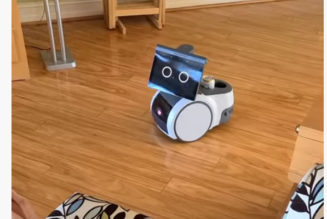Google has announced several new features for its Nest thermostats centered around helping the smart home become a bigger partner in the battle against climate change. These features are wrapped up in a new service called Nest Renew.
The service will use intelligent automation to allow the thermostats to communicate with energy providers and make it easier for Nest users to know when there is cleaner and / or cheaper energy on their local power grid. The device will then automatically adjust to use that energy at optimal times without you having to do a thing.
Nest Renew is the “First program of its kind,” said Google CEO Sundar Pichai, and it is entirely opt-in. It includes five main features:
- Energy Shift — automatic shifting of heating and cooling to times when energy is cheaper and / or cleaner
- Monthly Impact Reports — a rundown of how clean the energy a home is using is, based on time of day, so people can adjust when they use non-connected devices to take advantage of clean energy
- Energy Impact Program — an option to gamify your eco-friendly choices. Users collect Nest’s green leaves to earn a vote in how Nest directs funds to clean energy nonprofits
- Clean Energy Match — the ability to match estimated fossil fuel electricity use at home with renewable energy credits (RECs) from US solar and wind plants
- Schedule Tuneups — a new version of the existing Seasonal Savings feature that makes small adjustments to your HVAC schedule based on the time of year to optimize energy use
Nest’s existing demand-side response program, Rush Hour Rewards, which is an energy-saving program where the utility company can remotely adjust a household’s thermostat to relieve pressure on the grid, will continue as a separate service. People can choose to run both services on their thermostat simultaneously, with the Rush Hour program taking priority.
Nest Renew will work on Nest’s newest thermostats, which are the third-generation Nest Learning Thermostat, the Nest Thermostat E, and the Nest Thermostat. Visual indicators on the thermostat, emails, and activity summaries will tell Nest users when the various functions are active.
There are two levels to Nest Renew: Renew Basic, which is free and will be available across the continental US, and Renew Premium, which costs $10 a month and is limited to select markets at launch (Google didn’t say which). The premium tier adds two features for $10 a month; the Clean Energy Match, which is a way to match the fossil fuel energy used with renewable energy certificates that come from solar and wind plants in the US, and the option to pay utility bills through Nest Renew.
The main feature of Nest Renew is Energy Shift, and this is available in both the paid and free plans. This will automatically shift heating and cooling energy use to times when energy is cleaner and / or cheaper. Ben Brown, director of Product Management at Nest, explained that it will use small shifts — such as pre-cooling a house five or 10 minutes before the wind starts dying down or new demand spikes causing new energy plants to come online. “It will be just small coordinations based upon the needs of the grid that don’t sacrifice comfort at all,” he said. Nest customers will be able to manually adjust their thermostats if at any given moment they decide they’d rather be more comfortable than more green.
Depending on where you live and who your energy provider is, the power coming to your home could be generated by fossil fuels during one part of the day and wind or solar at another. Google says Energy Shift uses intelligent automation to make adjustments based on forecasts of the type of power on the grid. It then adapts energy use to prioritize clean energy. The company partnered with the non-profit WattTime, which has developed algorithms to determine the marginal emissions rates of the grid in real time.
Energy Shift can also adjust around any “time-of-use” charges your energy provider might have. Time-of-use charges are when you are charged more for using electricity at, say, 7PM — when everyone is home cooking dinner and watching Netflix — than you would be if you did those activities at, say, 2AM. Time-of-use charging is prevalent in Europe and the UK but not so common in the US — yet. But it is coming. Energy providers see it as a way to incentivize people to use energy when there is less demand, helping them better balance demand on the grid.
Nest says Energy Shift is a way its customers can navigate this change. “Certain regions are making it mandatory to move over to time-of-use plans — California and Michigan, for example,” said Brown. “Nest Renew will empower customers to manage their consumption against these time-of-use plans to make sure they can minimize their energy bills.”
:no_upscale()/cdn.vox-cdn.com/uploads/chorus_asset/file/22903683/Person_on_Couch_Viewing_Nest_Renew.jpg)
Time-of-use rates can be tricky to navigate. Running your HVAC system, for example, isn’t as easy to time as, say, running the dishwasher — which is something you can put off. Having a smart thermostat manage those calculations could make it easier.
Nest says it’s hoping to roll out Nest Renew to more household devices in the future, tying in with its smart displays and Google Home ecosystem. “We want to look at opportunities to empower other devices to coordinate with the needs of the grid; a good example would be electric vehicles,” said Brown.
RMI, a nonprofit working to accelerate the country’s transition to clean energy, analyzed the Nest Renew program and concluded that products like this could reduce around 50 million metric tons of CO2 per year if 10 million households participate. That’s approximately 7 percent of the gap between today’s level of household emissions and the US’s current target, which aims to cut emissions in half by 2030. With close to 123 million households in the US, the impact smart, connected homes could have on the climate change challenge will be even greater if even more people participate.
Nest Renew will start in an invitation-only preview in the coming weeks. Sign up at nestrenew.google.com to join the list.









